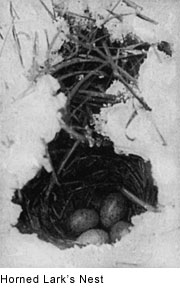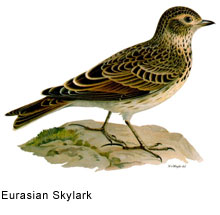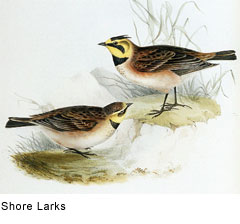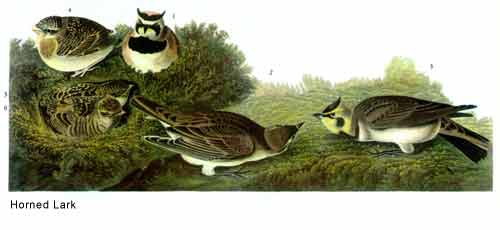|
 Take a Long Look at the Lark: Most larks are fairly dull in appearance. Like many ground birds, most lark species have long hind claws, which are thought to provide stability while standing. Take a Long Look at the Lark: Most larks are fairly dull in appearance. Like many ground birds, most lark species have long hind claws, which are thought to provide stability while standing.
Dull but Daring: Larks are small terrestrial birds with often extravagant songs and display flights. This fact, combined with a willingness to expand into anthropogenic habitats - as long as these are not too intensively-managed - has ensured larks
a prominent place in literature and music (the skylark being eulogised in "The Lark Ascending" (1914) by Ralph Vaughan Williams, for example).
In Life and Love... Larks feed on insects and seeds, and nest on the ground, laying 2-6 speckled eggs in each brood.
----------------------------------------------------------------------------------------------------------------------------
Skylark
Just the Facts: The Skylark (Alauda arvensis) is a 16-18 cm long passerine bird. It breeds across most of Europe and Asia and in the mountains of north Africa. It is mainly resident in the west of its range, but eastern populations of are more migratory, moving further south in winter. Even in the milder west of its range, many birds move to lowlands and the coast in winter. Asian birds appear as vagrants in Alaska; this bird has also been introduced in Hawaii and western North America
 Sky Song: The Skylark is known throughout its range for the song of the male birds, Sky Song: The Skylark is known throughout its range for the song of the male birds,
which is delivered in hovering flight from heights of 50-100 meters, when the bird itself may be appear to be just a dot in the sky
from the ground.
The song is generally 2 to 3 minutes long and it tends to get longer later in the season. The males have broader wings than the females. This adaptation for more efficient hovering flight has probably evolved owing to female birds' preference for males that hover and sing for longer periods - probably as an indicator of overall fitness.
Watch Where You Step! The skylark makes a grass nest on the ground. Generally the nests are very difficult to find, hidden between foliage. 3-6 eggs are laid in June. A second or third brood may be started later in the year. The eggs are yellow/white with brownish/purple spots mainly at the large end.
The skylark has featured in many songs, poems and other works of literature and art.
In the Fleetwood Mac song "Rhiannon", Stevie Nicks sings about
the title character that: She rules her life like a fine skylark
Percy Bysshe Shelley's well known poem "To a Skylark" begins:
Hail to thee, blithe spirit!
Bird thou never wert!
The poem "The Lark Ascending" of 112 lines by George Meredith inspired the orchestral music also called "The Lark Ascending" by Ralph Vaughan Williams.
Johnny Mercer was the lyricist, and Hoagy Carmichael the composer for the popular song "Skylark".
Skylark was also the title of the sequel to Sarah, Plain and Tall. Patricia MacLachlan was the author of both books.
The children's song "Alouette" is about plucking a skylark (alouette is the French word for skylark).----------------------------------------------------------------------------------------------------------------------------
Shore Lark
 Cold Comfort: The Shore Lark (Eremophila alpestris), called the Horned Lark in North America, breeds across much of North America from the high Arctic south to northernmost Europe and Asia, and in the mountains of southeast Europe. There is also an isolated population on a plateau in Colombia. Cold Comfort: The Shore Lark (Eremophila alpestris), called the Horned Lark in North America, breeds across much of North America from the high Arctic south to northernmost Europe and Asia, and in the mountains of southeast Europe. There is also an isolated population on a plateau in Colombia.
It is mainly resident in the south of its range, but northern populations of this passerine bird are migratory, moving further south in winter.
Habitat: This is a bird of open ground. In Eurasia it breeds above the tree line in mountains and the far north. In most of Europe, it is most often seen on seashore flats in winter, leading to the European name. In America, where there are no other larks to compete with, it's also found on farmland, on prairies, in deserts, on golf courses and airports, and the like.
She's Got the Lark: Unlike most other larks, this is a distinctive-looking species on the ground, mainly brown-grey above and pale below, with a striking black and yellow face pattern. The summer male has black "horns", which give this species its American name. America has a number of races distinguished by the face pattern and back color of males, especially in summer. The southern European mountain race Eremophila alpestris penicillata is greyer above, and the yellow of the face pattern is replaced with white.
Sounds and Songs: Vocalizations are high-pitched, lisping or tinkling, and weak. The song, given in flight as is common among larks, consists of a few chips followed by a warbling, ascending trill.
Grounded: The nest is on the ground, with 2-5 eggs being laid. Food is seeds supplemented with insects in the breeding season.

All text is available under the terms
of the GNU Free Documentation License
|